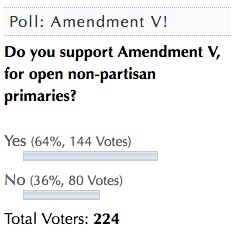 The latest Dakota Free Press poll finds strong support among blog readers for Amendment V, the open non-partisan primary proposal. Conducted from Sunday, August 28, through breakfast today, Wednesday, August 31, the poll asked, simply, “Do you support Amendment V, for open non-partisan primaries?”
The latest Dakota Free Press poll finds strong support among blog readers for Amendment V, the open non-partisan primary proposal. Conducted from Sunday, August 28, through breakfast today, Wednesday, August 31, the poll asked, simply, “Do you support Amendment V, for open non-partisan primaries?”
Out of 224 total votes, 144 of you said Yes; 80 of you said No. That’s 64% in favor, 36% opposed.
I have heard opposition to Amendment V from a number of my fellow Democrats, who worry that removing party labels from our statewide, legislative, and county ballots (which we already do with city and school district ballots) and putting all candidates on a single primary ballot open to all voters will further weaken the South Dakota Democratic Party. If you believe that DFP readership is all Democrats, then this poll suggests that Amendment V is still prevailing among Democrats nearly two to one.
Of course, if you read the comment section, you’ll see that we have a fair number of Republicans and independents participating as well. Republicans seeking their own partisan interest could take Amendment V either way. Republicans may not like giving up the popular “R” brand on the ballot to win last-minute inattentive voters. However, as many DFP readers have noted, Republicans could use the open non-partisan primary to crush lone Democrats and place two Republicans on the general election ballot.
Independents, on the other hand, should lean heavily in favor of Amendment V, since it guarantees their ability to vote for their leaders from the start instead of having to sit out many primary elections and wait for the general to have their say.
So consider this scenario, based on current voter registration totals:
- Suppose Democrats, 32% of the electorate, vote the way this poll comes out, 64% for V, 36% against.
- Suppose Republicans, 46% of the electorate, vote the opposite, 36% for V, 64% against.
- Suppose other voters, folks not belonging to the two major parties, 22% of the electorate, tend to favor an open nonpartisan primary. If the “other voters” lean toward V by 60% or better, V wins.
The comment section is open for your calculations and prognostications. I leave it to you to decide whether you want to include your party label.
Independents should vote for this proposal that will virtually guarantee there will never be an independent on the ballot in November? That’s a rhetorical question.
Ror, I don’t know. With the prospect of some jungle primaries maybe a lone wolf independent gets in the top two and then wins the general over a tea party Republican.
Cory, I had to verify your math because it was hard to believe that you only need 60% of the independents when almost two-thirds of R’s vote against it. V might have a decent chance.
Ror, I disagree on your odds. It may be harder to make the general election ballot, but recall my reasoning from earlier in the month that V may actually give independents better overall chances of winning. Sure, scoring second in an open nonpartisan primary is a lot harder than simply circulating a petition and getting enough signatures to make the general election ballot, but scoring second in a primary by beating just major party candidate is easier than scoring first in the general by beating both major party candidates.
Darin, I checked—the numbers hold! Check out this table:
I base those numbers on 100% turnout. The same percentages hold if turnout is the same for all three groups. If Trump depresses GOP turnout, the margin we need from the other two groups shrinks.
And I’ll stick with my read of the independents: more of them will think, “I get to vote in every primary? Cool!” than will do Ror’s electoral math and worry about non-major party candidates’ chances in November. Independents in general just aren’t that wonky.
Just got a phone poll from CRC Research on IM-22. They are testing out anti-22 messages and asking to rate the effectiveness of different messages.
(CRC? I get an Australian outfit, a Canadian outfit….)